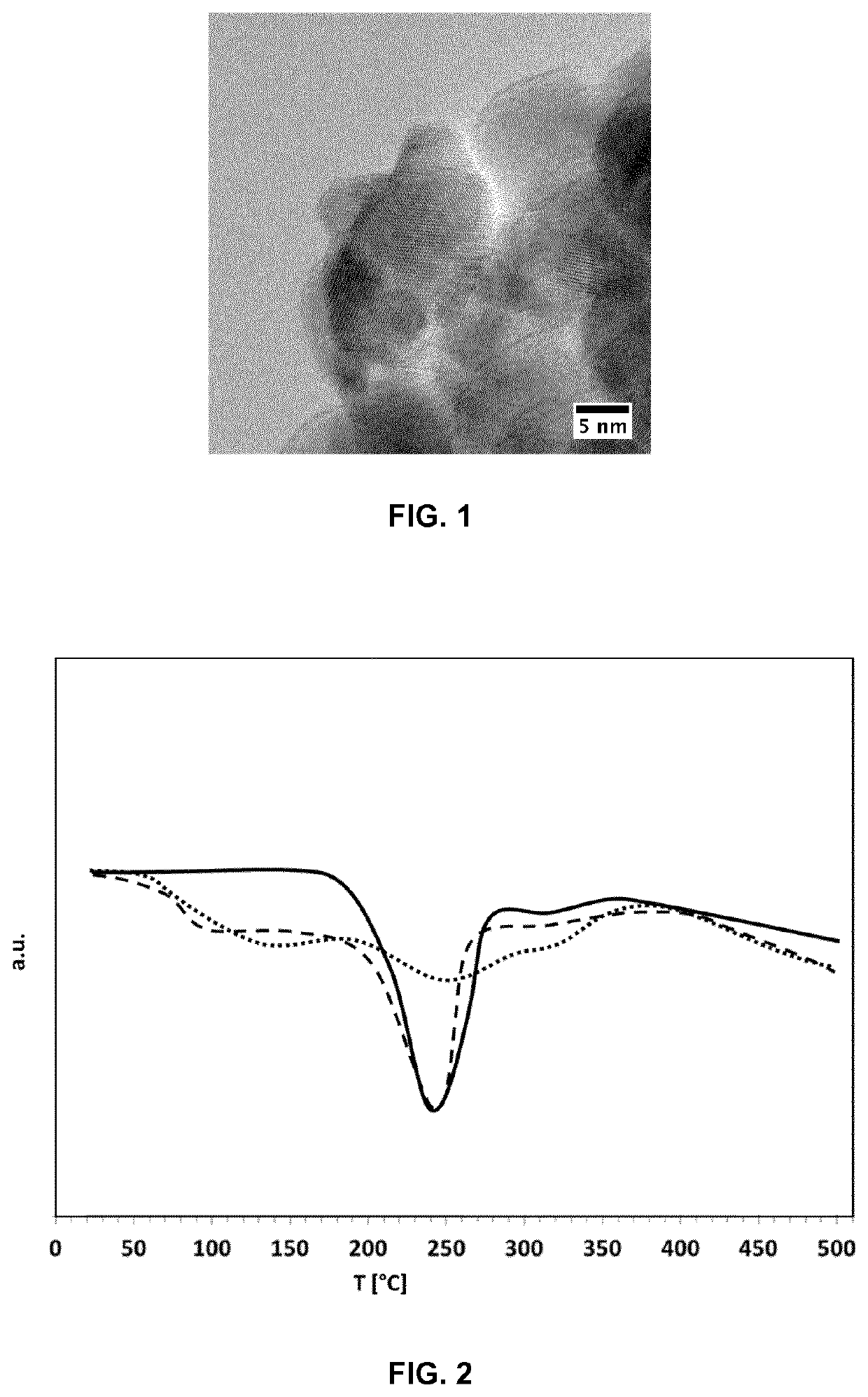Method for preparing catalytic nanoparticles, catalyst surfaces, and/or catalysts
a technology of catalytic nanoparticles and catalyst surfaces, applied in the field of catalytic particles, catalyst surfaces, or catalysts, can solve the problems of catalytic nanoparticles, catalyst amorphisation, or support, and achieve the effect of improving catalytic properties and high-efficiency treatment of catalytic starting materials
- Summary
- Abstract
- Description
- Claims
- Application Information
AI Technical Summary
Benefits of technology
Problems solved by technology
Method used
Image
Examples
example 1
[0246]Starting material 1, 600 mg Pt / Ce0.68Zr0.32O2, was placed in a microimplantor designed by the company Quertech, now Ionics, including an ECR (Electron Cyclotron Resonance) ion source powered by a 10 GHz and 50 W HF amplifier, and an ion extraction system of 10 kV (kiloVolt). The plasma of the ion source was confined by permanent magnets allowing the production of monocharged and multicharged ions).
[0247]600 mg of Pt / Ce0.68Zr0.32O2 catalyst particles agglomerated in powder form was spread over a surface of 400 cm2 and submitted to 16 treatments with a partial dose of ions of 5×1015 ions / cm2, between each treatment the powder was mixed and then spread again on the same surface of 400 cm2. Due to the poor distribution mentioned above only about 120 to 200 cm2 are effectively covered by the starting material. The surface density of the catalyst particles is thus 0.003 to 0.005 g / cm2 and the resulting dosage is between 1.60×1019 to 2.67×1019 ions / g. The dosage is the same for ex...
example 2
[0248]Starting material 2, 600 mg of Pt / γ-Al2O3 catalyst particles agglomerated in powder form, was spread over a surface of 400 cm2 and submitted to 16 treatments with a partial dose of ions of 5×1015 ions / cm2, between each treatment the powder was mixed and then spread again on the same area of 400 cm2. The treatment was performed with mono and multicharged nitrogen ions (58% N+, 32% N2 +, 9% N3+, 1% N4+) extracted by an extraction voltage of 35 kV, i.e. with a mean charge state of 1.53 and mean energy Eavr equal to 53 keV. The moving of the ion beam consisted in a succession of round-trips on a surface treatment of 68×28 cm2 with a speed of 80 mm / s, each round trip was performed with an advancement step corresponding to a fraction of the ion beam diameter of 30%, in other words corresponding to an absolute shift of 6.75 mm (30% of 22.5 mm). The ion beam current to ion beam cross-section area ratio was 2.52 μA / mm2. The pressure in the treatment chamber was 10−5 mbar.
example 3
[0249]Starting material 3, 600 mg of Ce0.68Zr0.32O2 support nanoparticles in agglomerated powder from, was spread over an area of 400 cm2 and submitted to 16 treatments with a partial dose of ions of 5×1015 ions / cm2, between each treatment the powder was mixed and then spread again on the same area of 400 cm2. The treatment was performed with mono and multicharged nitrogen ions (58% N+, 32% N2+, 9% N3+, 1% N4+) extracted by an extraction voltage of 35 kV, i.e. with a mean charge state of 1.53 and mean energy Eavr equal to 53 keV. The moving of the ion beam consisted in a succession of round-trips covering a total area of 68×28 cm2 with a speed of 80 mm / s, each round trip was performed with an advancement step corresponding to a fraction of the ion beam diameter of 30%, in other words corresponding to an absolute shift of 6.75 mm (30% of 22.5 mm). The ion beam current to ion beam cross-section area ratio was 2.52 μA / mm2. The pressure in the treatment chamber was 10−5 mbar.
PUM
| Property | Measurement | Unit |
|---|---|---|
| energy | aaaaa | aaaaa |
| energy | aaaaa | aaaaa |
| atomic number | aaaaa | aaaaa |
Abstract
Description
Claims
Application Information
 Login to View More
Login to View More - R&D
- Intellectual Property
- Life Sciences
- Materials
- Tech Scout
- Unparalleled Data Quality
- Higher Quality Content
- 60% Fewer Hallucinations
Browse by: Latest US Patents, China's latest patents, Technical Efficacy Thesaurus, Application Domain, Technology Topic, Popular Technical Reports.
© 2025 PatSnap. All rights reserved.Legal|Privacy policy|Modern Slavery Act Transparency Statement|Sitemap|About US| Contact US: help@patsnap.com


